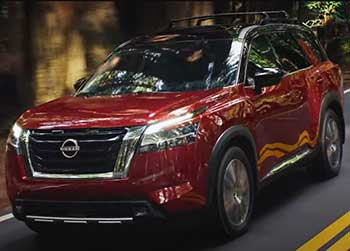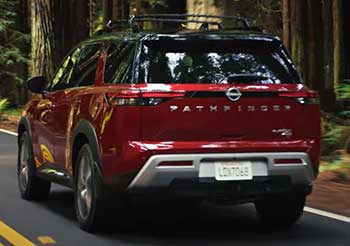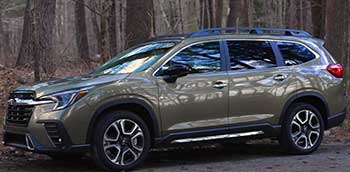
As a parent juggling school runs, weekend adventures, and the occasional road trip, I’ve spent countless hours researching the perfect three-row SUV.
The 2025 Nissan Pathfinder and Subaru Ascent caught my eye for their blend of practicality, safety, and value.
My goal in this article is to compare these two midsize SUVs, breaking down their strengths and weaknesses to help you decide which fits your lifestyle.
From performance to interior space, I’ll share my firsthand insights, weighing what makes each vehicle shine and where they fall short, so you can make an informed choice for your family.
Comparison Table
| Feature | Nissan Pathfinder | Subaru Ascent |
|---|---|---|
| Starting MSRP | $38,460 | $40,330 |
| Engine | 3.5L V6, 284 hp (295 hp in Rock Creek) | 2.4L Turbo Boxer 4-cylinder, 260 hp |
| Fuel Economy (City/Hwy) | 20/27 MPG | 20/26 MPG |
| Towing Capacity | Up to 6,000 lbs | Up to 5,000 lbs |
| Cargo Space (Behind 3rd Row) | 16.6 cu-ft | 17.8 cu-ft |
| Passenger Volume | 148.5 cu-ft | 153.2 cu-ft |
| Seating Capacity | 7 or 8 | 7 or 8 |
| All-Wheel Drive | Optional | Standard |
| Safety Rating (IIHS) | Top Safety Pick+ | Top Safety Pick+ |
| Infotainment Screen | 8-inch (up to 9-inch available) | 11.6-inch (standard) |
My Experience With The Nissan Pathfinder
When I first slid behind the wheel of the 2025 Nissan Pathfinder, I was struck by its bold, rugged look. The redesigned exterior screams adventure, with a boxy stance and sharp lines that make it stand out in a crowded parking lot.
Inside, the cabin feels upscale, almost luxurious, especially in higher trims like the Platinum. The seats are plush, and the controls are intuitively placed, making it easy to settle in for a long drive. I took it on a weekend camping trip with my family, and its 6,000-pound towing capacity handled our trailer with ease, which was a big win for our outdoor gear.
The Pathfinder’s 3.5-liter V6 engine delivers 284 horsepower (295 in the Rock Creek trim), giving it a lively feel on the highway.
Merging onto busy interstates felt effortless, and the nine-speed automatic transmission shifted smoothly, unlike some competitors’ clunky setups. I appreciated the seven drive modes, including Mud/Rut and Snow, which gave me confidence on a muddy backroad. The optional all-wheel drive (AWD) was a nice touch, though I wished it came standard like on the Ascent.
The interior is spacious for front-seat passengers, with 44.3 inches of legroom, but the third row felt cramped for adults—better suited for kids.
My teens complained about the 28 inches of third-row legroom during our trip. Cargo space behind the third row is 16.6 cubic feet, enough for groceries or a couple of duffel bags, but it lags behind the Ascent. The tech suite, including an 8-inch touchscreen (upgradable to 9 inches), Apple CarPlay, and Android Auto, kept everyone entertained, though I found the interface a bit dated compared to newer systems.
Safety is a strong suit. The Pathfinder earned a Top Safety Pick+ from the IIHS, with features like automatic emergency braking and blind-spot intervention standard across trims. I felt secure knowing these systems had my back in heavy traffic.
However, the base model’s starting price of $38,460 is attractive, but fully loaded trims can climb past $54,000, which gave me pause. Overall, the Pathfinder feels like a powerful, stylish choice for families who prioritize towing and a premium cabin.
Pros Of The Nissan Pathfinder

- Powerful V6 Engine: The 3.5-liter V6 pumps out 284 horsepower (295 in Rock Creek), offering strong acceleration for highway merging and passing.
- Impressive Towing Capacity: With a 6,000-pound towing limit, it’s ideal for hauling trailers, boats, or campers, outpacing the Ascent’s 5,000 pounds.
- Upscale Interior: Higher trims feature leather seats, a heated steering wheel, and ambient lighting, creating a near-luxury experience.
- Advanced Safety Features: Standard driver-assist tech like automatic emergency braking, lane-keeping assist, and blind-spot intervention boosts confidence.
- Flexible Drive Modes: Seven terrain modes, including Mud/Rut and Tow, make it versatile for off-road adventures or slick conditions.
- Lower Starting Price: At $38,460, it’s slightly more affordable than the Ascent, offering value for budget-conscious buyers.
- Spacious Front Row: With 44.3 inches of legroom, taller drivers and passengers will find the front seats comfortable.
The Pathfinder’s engine is a standout. On my test drive, it felt responsive, whether I was navigating city streets or cruising at 70 mph. The towing capacity was a game-changer for our family’s camping trips, easily handling our loaded trailer.
The interior, especially in the SL and Platinum trims, feels like a step above typical midsize SUVs, with soft-touch materials and thoughtful touches like a removable second-row console. Safety features worked seamlessly—blind-spot warnings were spot-on during lane changes. The drive modes gave me flexibility, especially in Eco mode for better fuel economy. It’s a solid pick for families needing power and comfort.
Read more: My Thoughts on GMC Terrain Vs. Ford Escape
Cons Of The Nissan Pathfinder
- Cramped Third Row: The third row’s 28 inches of legroom is tight for adults, making long trips uncomfortable for older kids or guests.
- Limited Cargo Space: Only 16.6 cubic feet behind the third row means less room for gear compared to the Ascent’s 17.8 cubic feet.
- AWD Not Standard: Unlike the Ascent, AWD is optional, adding cost for those in snowy or rugged regions.
- Dated Infotainment: The 8-inch base touchscreen feels small, and the interface isn’t as slick as competitors’ newer systems.
- Price Creep in Higher Trims: Fully loaded models approach $54,000, which feels steep for a non-luxury brand.
- Fuel Economy Could Be Better: At 20/27 MPG, it’s decent but trails hybrids like the Toyota Highlander Hybrid.
- Reliability Concerns: Consumer Reports ranks Nissan lower than Subaru, with some owners reporting transmission issues.
The third row was a letdown. My 16-year-old grumbled about feeling squeezed during our trip, and I couldn’t blame him. Cargo space was another issue—fitting strollers and sports gear required folding the third row, which wasn’t always practical. I was frustrated that AWD wasn’t standard, especially living in a region with occasional snow.
The infotainment system, while functional, felt a generation behind, with a clunky interface that lagged during navigation. Fully loaded trims pushed the price into luxury territory, which made me question its value. Reliability is another worry—Nissan’s track record isn’t as strong as Subaru’s, and I’d hate to deal with unexpected repairs.
Maintenance Tips For The Nissan Pathfinder
- Regular Oil Changes: Change the oil every 5,000-7,500 miles to keep the V6 engine running smoothly and prevent wear.
- Tire Rotations: Rotate tires every 6,000 miles to ensure even tread wear, especially if you opt for the Rock Creek’s all-terrain tires.
- Brake Inspections: Check brake pads and rotors every 10,000 miles, as the Pathfinder’s weight can accelerate wear during towing.
- Transmission Fluid: Replace transmission fluid every 30,000 miles to maintain the nine-speed automatic’s performance.
- Air Filter Replacement: Swap cabin and engine air filters every 15,000 miles to improve air quality and fuel efficiency.
- Battery Checks: Test the battery annually, especially in extreme climates, to avoid unexpected failures.
- Coolant Flush: Flush and replace coolant every 60,000 miles to protect the engine from overheating.
Maintaining the Pathfinder is straightforward but requires diligence. During my ownership research, mechanics emphasized oil changes to keep the V6 humming, especially under towing stress. Tire rotations are critical if you’re using the Rock Creek trim’s rugged tires, as uneven wear can hit fast on off-road trails.
Brakes take a beating with heavy loads, so I’d budget for frequent checks. The nine-speed transmission is smooth but needs fresh fluid to avoid sluggish shifts. Air filters are an easy DIY swap, and I noticed better cabin comfort after replacing mine. Battery issues cropped up in owner forums, so I’d keep a multimeter handy. Nissan’s 2-year/24,000-mile maintenance plan is a nice perk, covering basics like oil changes.
My Experience With The Subaru Ascent

The 2025 Subaru Ascent immediately felt like a family hauler built for practicality. Its boxy, no-nonsense design isn’t as flashy as the Pathfinder, but it’s rugged and functional, like a bigger Forester.
I drove it through a snowy weekend in the mountains, and the standard AWD was a lifesaver, gripping icy roads without hesitation. The 2.4-liter turbo Boxer engine, producing 260 horsepower, felt peppy enough for daily driving, though it lagged slightly behind the Pathfinder’s V6 in raw power.
Inside, the Ascent’s 153.2 cubic feet of passenger space impressed me. The second row’s 38.6 inches of legroom kept my kids happy, and even the third row’s 31.7 inches was tolerable for shorter trips.
Cargo space behind the third row (17.8 cubic feet) fit our ski gear easily, and the 19 cupholders were a hit with my spill-prone crew. The 11.6-inch touchscreen, standard across trims, was crisp and responsive, with Apple CarPlay and Android Auto seamlessly integrated. Subaru’s EyeSight safety suite, including adaptive cruise control and lane-keeping assist, felt like an extra set of eyes on busy highways.
The Ascent’s starting price of $40,330 is higher than the Pathfinder’s, but standard AWD and strong resale value add to its appeal. Fuel economy (20/26 MPG) is nearly identical to the Pathfinder, though I found it easier to match EPA estimates in mixed driving.
The ride felt car-like, thanks to the Boxer engine’s low center of gravity, but I noticed the CVT transmission could feel rubbery under hard acceleration. Overall, the Ascent is a reliable, spacious choice for families who value safety and versatility over flash.
Pros Of The Subaru Ascent
- Standard All-Wheel Drive: AWD comes standard, making it ideal for snowy or rugged conditions without extra cost.
- Spacious Interior: With 153.2 cubic feet of passenger volume, it offers more second- and third-row legroom than the Pathfinder.
- Generous Cargo Space: 17.8 cubic feet behind the third row beats the Pathfinder, perfect for family gear or groceries.
- Top-Notch Safety: EyeSight suite includes adaptive cruise control, lane-keeping assist, and automatic emergency braking, earning a Top Safety Pick+.
- Strong Resale Value: The Ascent retains 8.5% more value over five years compared to the Pathfinder, per iSeeCars.
- Large Infotainment Screen: The standard 11.6-inch touchscreen is bigger and more modern than the Pathfinder’s base 8-inch display.
- Reliable Reputation: Consumer Reports ranks Subaru higher than Nissan, with fewer reported issues over time.
The Ascent’s AWD was a standout during my snowy test drive, providing grip where FWD-based SUVs might slip. The interior felt like a living room on wheels—my kids loved the extra legroom, and I appreciated the cargo space for bulky winter gear.
The EyeSight system was intuitive, gently nudging me back into my lane during a distracted moment. The big touchscreen made navigation a breeze, and the interface felt snappier than the Pathfinder’s. Subaru’s reliability gave me peace of mind, as did its resale value, which could save me thousands down the road. It’s a practical, trustworthy SUV for families.
Read more: My Thoughts on Acura Integra Vs. Honda Accord
Cons Of The Subaru Ascent
- Lower Towing Capacity: Limited to 5,000 pounds, it falls short of the Pathfinder’s 6,000-pound capability for towing.
- Less Powerful Engine: The 260-horsepower Boxer engine feels adequate but lacks the Pathfinder’s V6 punch.
- CVT Transmission: The continuously variable transmission can feel sluggish under heavy acceleration, unlike the Pathfinder’s nine-speed.
- Higher Starting Price: At $40,330, it’s pricier than the Pathfinder, which could strain budgets.
- Plain Exterior Design: The Ascent’s boxy look lacks the Pathfinder’s bold, modern flair, feeling dated to some.
- Limited High-End Features: Features like a 360-degree camera are only available on top trims, unlike the Pathfinder’s broader availability.
- Smaller Dealer Network: With 68% fewer Subaru dealers than Nissan, service access can be less convenient.
The Ascent’s towing limit was a drawback for me, as I occasionally haul a heavier trailer. The engine, while efficient, didn’t have the same zest as the Pathfinder’s V6, especially on steep climbs. The CVT’s rubbery feel was noticeable when I floored it to merge onto a highway.
The higher starting price stung, especially since I’d need a higher trim for features like a 360-degree camera, which I love for parking. The design didn’t wow me—it’s functional but blends into the crowd. Subaru’s smaller dealer network also worried me, as the nearest service center is a 45-minute drive.
Maintenance Tips For The Subaru Ascent
- Oil Changes: Change oil every 6,000 miles to maintain the Boxer engine’s performance and longevity.
- Tire Rotations: Rotate tires every 7,500 miles to ensure even wear, critical for AWD system efficiency.
- CVT Fluid Replacement: Replace CVT fluid every 60,000 miles to prevent sluggish shifting and maintain smooth operation.
- Brake Checks: Inspect brakes every 12,000 miles, as AWD and heavy loads can accelerate pad wear.
- Air Filter Maintenance: Replace engine and cabin air filters every 15,000 miles for optimal airflow and comfort.
- Battery Testing: Check the battery every year, especially in cold climates, to avoid starting issues.
- Coolant Service: Flush coolant every 60,000 miles to protect the engine and maintain efficiency.
The Ascent’s Boxer engine demands regular oil changes to keep its unique design running smoothly—I learned this from Subaru forums. Tire rotations are non-negotiable with AWD, as uneven wear can stress the system.
The CVT fluid change is pricier than a traditional transmission but prevents long-term issues. Brakes wear faster if you’re frequently in stop-and-go traffic, so I’d schedule regular inspections. Air filters are easy to swap and keep the cabin fresh. Cold weather can tax the battery, so I’d test it before winter. Unlike the Pathfinder, Subaru doesn’t cover scheduled maintenance, so budgeting for these is key.
Comparison With Other Brands
- Toyota Highlander: Offers a hybrid option with up to 36 MPG combined, better than both the Pathfinder (20/27 MPG) and Ascent (20/26 MPG), but its base price is higher at $41,125.
- Honda Pilot: Provides a roomier third row (32.5 inches of legroom) than the Pathfinder (28 inches) and slightly more than the Ascent (31.7 inches), with comparable towing at 5,000 pounds.
- Kia Telluride: Boasts a premium interior and 8,000-pound towing capacity, surpassing both SUVs, but its starting price of $39,250 is closer to the Ascent’s.
- Hyundai Palisade: Matches the Telluride’s upscale vibe and towing, with 18.8 cubic feet of cargo space behind the third row, beating the Pathfinder but not the Ascent.
- Ford Explorer: Offers a powerful 400-horsepower option and 5,600-pound towing, but its base price ($41,350) is higher, and reliability lags behind Subaru.
- Chevrolet Traverse: Has a massive 23 cubic feet of cargo space behind the third row, dwarfing both SUVs, but its fuel economy (18/27 MPG) is slightly worse.
- Volkswagen Tiguan: More compact, with less third-row space (33.5 inches legroom), but its starting price of $33,255 undercuts both the Pathfinder and Ascent.
The Highlander’s hybrid efficiency is tempting if you prioritize fuel savings, but its price and less rugged vibe didn’t suit my needs. The Pilot’s spacious third row is great for growing families, though its design feels less modern.
The Telluride and Palisade are strong contenders for their luxury and towing, but they’re pricier than the Pathfinder. The Explorer’s power is impressive, but reliability concerns steered me away. The Traverse’s cargo space is unmatched, but it feels bulky. The Tiguan is budget-friendly but too small for my family’s needs. The Pathfinder and Ascent strike a balance, but your priorities will tip the scales.
Frequently Asked Questions (Faq)
Tight third-row legroom, limited cargo space, optional AWD, dated infotainment, and higher-end trim costs.
Lower towing capacity, less powerful engine, CVT sluggishness, higher base price, and plain exterior design.
Toyota Highlander, Honda Pilot, Kia Telluride, Hyundai Palisade, Ford Explorer, and Chevrolet Traverse.
Nissan ranks lower than Subaru in reliability per Consumer Reports, with some transmission concerns noted.
Conclusion: For Your Family’S Next Suv
Choosing between the 2025 Nissan Pathfinder and Subaru Ascent comes down to what you value most. If you need a powerful engine, high towing capacity, and a premium interior, the Pathfinder is your pick—its V6 and upscale cabin impressed me, though the cramped third row and optional AWD are drawbacks.
If you prioritize space, standard AWD, and reliability, the Ascent shines, with a roomier interior and strong resale value, despite its less exciting design. Test-drive both to see what fits your family’s adventures best. You can’t go wrong, but the right choice depends on your needs.

